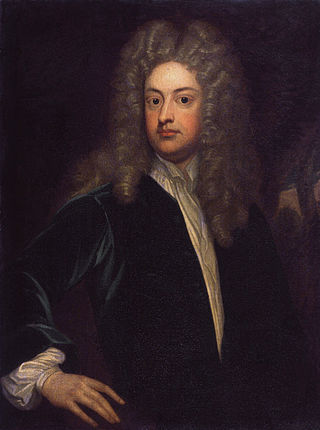
Joseph Addison was an English essayist, poet, playwright, and politician. He was the eldest son of Lancelot Addison. His name is usually remembered alongside that of his long-standing friend Richard Steele, with whom he founded The Spectator magazine. His simple prose style marked the end of the mannerisms and conventional classical images of the 17th century.

Sir Richard Steele was an Anglo-Irish writer, playwright and politician best known as the co-founder of the magazine The Spectator alongside his close friend Joseph Addison.
Isaac Bickerstaff Esq was a pseudonym used by Jonathan Swift as part of a hoax to predict the death of then-famous Almanac-maker and astrologer John Partridge.

John Dennis was an English critic and dramatist.

Augustan literature is a style of British literature produced during the reigns of Queen Anne, King George I, and George II in the first half of the 18th century and ending in the 1740s, with the deaths of Alexander Pope and Jonathan Swift, in 1744 and 1745, respectively. It was a literary epoch that featured the rapid development of the novel, an explosion in satire, the mutation of drama from political satire into melodrama and an evolution toward poetry of personal exploration. In philosophy, it was an age increasingly dominated by empiricism, while in the writings of political economy, it marked the evolution of mercantilism as a formal philosophy, the development of capitalism and the triumph of trade.

The Guardian was a short-lived newspaper published in London from 12 March to 1 October 1713.

Augustan prose is somewhat ill-defined, as the definition of "Augustan" relies primarily upon changes in taste in poetry. However, the general time represented by Augustan literature saw a rise in prose writing as high literature. The essay, satire, and dialogue thrived in the age, and the English novel was truly begun as a serious art form. At the outset of the Augustan age, essays were still primarily imitative, novels were few and still dominated by the Romance, and prose was a rarely used format for satire, but, by the end of the period, the English essay was a fully formed periodical feature, novels surpassed drama as entertainment and as an outlet for serious authors, and prose was serving every conceivable function in public discourse. It is the age that most provides the transition from a court-centered and poetic literature to a more democratic, decentralized literary world of prose.

Justus van Effen was a Dutch writer, who wrote chiefly in French but also made crucial contributions to Dutch literature. A journalist, he imitated The Spectator with the publication of the Dutch-language Hollandsche Spectator. He gained international fame as a writer of French periodicals and a translator from English into French, and he is also recognized as one of the most important Dutch language writers of the 18th century and an influential figure of the Dutch Enlightenment.

The Spectator was a daily publication founded by Joseph Addison and Richard Steele in England, lasting from 1711 to 1712. Each "paper", or "number", was approximately 2,500 words long, and the original run consisted of 555 numbers, beginning on 1 March 1711. These were collected into seven volumes. The paper was revived without the involvement of Steele in 1714, appearing thrice weekly for six months, and these papers when collected formed the eighth volume. Eustace Budgell, a cousin of Addison's, and the poet John Hughes also contributed to the publication.
The Rambler was a periodical by Samuel Johnson.
Nationality words link to articles with information on the nation's poetry or literature.

In 17th- and 18th-century England, coffeehouses served as public social places where men would meet for conversation and commerce. For the price of a penny, customers purchased a cup of coffee and admission. Travellers introduced coffee as a beverage to England during the mid-17th century; previously it had been consumed mainly for its supposed medicinal properties. Coffeehouses also served tea and hot chocolate as well as a light meal.

The Ladies' Mercury was a periodical published in London by the Athenian Society notable for being the first periodical in English published and specifically designed for women readers.

The Hollandsche Spectator was an important Dutch language newspaper of the Enlightenment period.

The Burney Collection consists of over 1,270 17th-18th century newspapers and other news materials, gathered by Charles Burney, most notable for the 18th-century London newspapers. The original collection, totalling almost 1 million pages, is held by the British Library.
John Morphew was an English publisher. He was associated with significant literary and political publications of the early 18th century. At one point publishing for both Whig and Tory factions, he later became identified with the Tories.

Martin Powell, was an Irish master puppeteer and puppet show impresario, who put on a repertoire of satirical and parodical marionette shows that invariably featured the Punch character. He drew audiences first at provincial towns such as Bath, then moving his venue to London. His theatre established itself in early 1710 at its first location, at the north end of St. Martin's Street intersected by Litchfield St., not quite in Covent Garden. But by 1711 he relocated the theatre to the galleries of Covent Garden, at Little Piazza, opposite St. Paul's Church.

Button's Coffee House was an 18th-century coffeehouse in London, England. It was situated in Russell Street, Covent Garden, between the City and Westminster.















